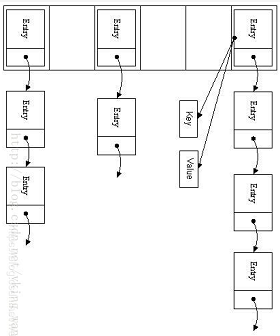Hashmap 的底层: 数组+链表 (jdk7之前)
数组+链表+红黑树(jdk 8)
以jdk7为例说明:
HashMap map=new HashMap();
在实例化以后,底层创建了长度是16的一维数组Entry[] table
……已经执行过多次put……
map.put(key1,value1):
首先计算key1所在类的hashCode()计算key1哈希值,此哈希值经过某种算法计算以后,得到在entry数组中的位置。
如果此位置上的数据为空,此时的key1-value1添加成功。—情况1
如果此位置上的数据不为空,()意味着此位置上存在一个或者多个数据(以链表形式存在),比较key1和已存在的一个或者多个数据的哈希值:
如果key1的哈希值与已经存在的数据的哈希值都不相同,此时key1-value1添加成功。—情况2
如果key1的哈希值和已经存在的某个数据key2-value2的哈希值相同,继续比较,调用key1的equals(key2)方法,比较:
如果equals()返回false:此时的key1-value1。—情况3
如果equals()返回true:使用value1替换value2.
关于情况2和情况3的 此时key1-value1和原来的数据以链表的方式存储
在不断的添加过程中,会涉及到扩容问题,默认的扩容原来的2 倍,并将原来的数据复制过来。

jDK8相较于jdk7的底层的方面的区别:
new HashMap()底层没有创建一个长度为16的数组
jdk 8 底层的数据是:Node[],而非Entry[]
首次调用Put方法时,底层创建长度为16的数组
jdk7的底层结构只有:数组+链表。jdk8中底层结构:数组+链表+红黑树
当数组的某一个索引位置上的元素以链表的形式存在的数据个数>8,且当前数组的长度>64时,此时的索引位置上的所有数据改为使用红黑树存储。
变量的介绍

具体代码:jdk7
调用空参构造函数HashMap
/**
* Constructs an empty <tt>HashMap</tt> with the default initial capacity
* (16) and the default load factor (0.75).
*/
public HashMap() {
this(DEFAULT_INITIAL_CAPACITY, DEFAULT_LOAD_FACTOR);
}
进一步:调用HashMap(int initialCapacity, float loadFactor)
/**
* The table, resized as necessary. Length MUST Always be a power of two.
*/
transient Entry<K,V>[] table;
/**
* Constructs an empty <tt>HashMap</tt> with the specified initial
* capacity and load factor.
*
* @param initialCapacity the initial capacity
* @param loadFactor the load factor
* @throws IllegalArgumentException if the initial capacity is negative
* or the load factor is nonpositive
* 传过来的参数:initialCapacity=16 loadFactor=0.75
*/
public HashMap(int initialCapacity, float loadFactor) {
if (initialCapacity < 0)
throw new IllegalArgumentException("Illegal initial capacity: " +
initialCapacity);
if (initialCapacity > MAXIMUM_CAPACITY)
initialCapacity = MAXIMUM_CAPACITY;
if (loadFactor <= 0 || Float.isNaN(loadFactor))
throw new IllegalArgumentException("Illegal load factor: " +
loadFactor);
// Find a power of 2 >= initialCapacity
int capacity = 1;
// 这里的capacity 的值为16
while (capacity < initialCapacity)
capacity <<= 1;
//赋值加载因子
this.loadFactor = loadFactor;
//16*0.75=12 这个12 扩容的阀值 ---临界值
threshold = (int)Math.min(capacity * loadFactor, MAXIMUM_CAPACITY + 1);
// 实例化Entry实体
table = new Entry[capacity];
useAltHashing = sun.misc.VM.isBooted() &&
(capacity >= Holder.ALTERNATIVE_HASHING_THRESHOLD);
init();
}
put方法介绍:
/**
* Associates the specified value with the specified key in this map.
* If the map previously contained a mapping for the key, the old
* value is replaced.
*/
public V put(K key, V value) {
//先判断key值是否为空值
if (key == null)
// 若为空值,则把value值控制放到table[0]或者table[0]的链表中
// 下面会接着介绍 putForNullKey()
return putForNullKey(value);
// 接着对key值进行hash得到哈希值
int hash = hash(key);
// 索引到该key值在数组中的位置
int i = indexFor(hash, table.length);
// 循环table[i] 的连表,找到改key-value对存放的地方。
// 若e不等于null 进入循环体,若e等于null则进行addEntry()方法。
for (Entry<K,V> e = table[i]; e != null; e = e.next) {
Object k;
// 判断该table[i]链表的上的某个key的哈希值是否等于 要存储的key的哈希值 和 该key
// 是否等于该table[i]链表的这个某个key值 若同时满足者进行更新该某个key对应的value值
if (e.hash == hash && ((k = e.key) == key || key.equals(k))) {
V oldValue = e.value;
e.value = value;
e.recordAccess(this);
return oldValue;
}
}
//保证并发访问时,若HashMap内部结构发生变化,快速响应失败
modCount++;
//若e等于null则进行addEntry()方法。
addEntry(hash, key, value, i);
return null;
}
接着介绍putForNullKey(value)方法:
/**
* Offloaded version of put for null keys
* 当key值为空的时候,调用该方法 把value值进行存在table[0]的链表中
*/
private V putForNullKey(V value) {
// 循环table[0]链表,若链表不空,则进行判断e.key是否为空,若为空则进行更新老值
for (Entry<K,V> e = table[0]; e != null; e = e.next) {
if (e.key == null) {
V oldValue = e.value;
e.value = value;
e.recordAccess(this);
return oldValue;
}
}
modCount++;
//若链表空,则进行插入新值
addEntry(0, null, value, 0);
return null;
}
addEntry(hash, key, value, i)方法的介绍
/**
* Adds a new entry with the specified key, value and hash code to
* the specified bucket. It is the responsibility of this
* method to resize the table if appropriate.
*
* Subclass overrides this to alter the behavior of put method.
*/
void addEntry(int hash, K key, V value, int bucketIndex) {
//这里的意思是先判断数组的里元素的个数是否大于临界值 12
// 和数组的中要放的位置是否为空
// 若大于12 且放的位置不为空,则进行扩容
if ((size >= threshold) && (null != table[bucketIndex])) {
//调用resize进行扩容 默认是原来的2倍
// 怎么扩容就这里不具体的将了!
resize(2 * table.length);
hash = (null != key) ? hash(key) : 0;
bucketIndex = indexFor(hash, table.length);
}
// 若不需要扩容,则进行添加entry
createEntry(hash, key, value, bucketIndex);
}
接着介绍createEntry()
/**
* Like addEntry except that this version is used when creating entries
* as part of Map construction or "pseudo-construction" (cloning,
* deserialization). This version needn't worry about resizing the table.
*
* Subclass overrides this to alter the behavior of HashMap(Map),
* clone, and readObject.
*/
void createEntry(int hash, K key, V value, int bucketIndex) {
//原有的数据先取出来,然后作为新实例化的entry实体的next的entry
// 把新的新实例化的entry实体放到原有的数据的位置上去
Entry<K,V> e = table[bucketIndex];
table[bucketIndex] = new Entry<>(hash, key, value, e);
size++;
}
entry实体:
static class Entry<K,V> implements Map.Entry<K,V> {
final K key;
V value;
Entry<K,V> next;
int hash;
/**
* Creates new entry.
*/
Entry(int h, K k, V v, Entry<K,V> n) {
value = v;
next = n;
key = k;
hash = h;
}
public final K getKey() {
return key;
}
public final V getValue() {
return value;
}
public final V setValue(V newValue) {
V oldValue = value;
value = newValue;
return oldValue;
}
public final boolean equals(Object o) {
if (!(o instanceof Map.Entry))
return false;
Map.Entry e = (Map.Entry)o;
Object k1 = getKey();
Object k2 = e.getKey();
if (k1 == k2 || (k1 != null && k1.equals(k2))) {
Object v1 = getValue();
Object v2 = e.getValue();
if (v1 == v2 || (v1 != null && v1.equals(v2)))
return true;
}
return false;
}
public final int hashCode() {
return (key==null ? 0 : key.hashCode()) ^
(value==null ? 0 : value.hashCode());
}
public final String toString() {
return getKey() + "=" + getValue();
}
/**
* This method is invoked whenever the value in an entry is
* overwritten by an invocation of put(k,v) for a key k that's already
* in the HashMap.
*/
void recordAccess(HashMap<K,V> m) {
}
/**
* This method is invoked whenever the entry is
* removed from the table.
*/
void recordRemoval(HashMap<K,V> m) {
}
}





















 1753
1753











 被折叠的 条评论
为什么被折叠?
被折叠的 条评论
为什么被折叠?








